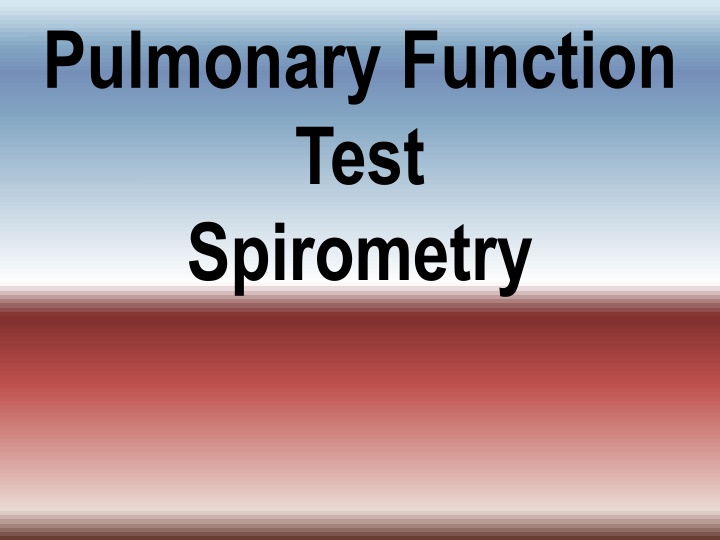
Pulmonary Function Test Spirometry
Learn about spirometry, a common method to measure lung function in diagnosing obstructive and restrictive pulmonary diseases. Discover how spirometric parameters like FEV1 and FVC are crucial in determining respiratory health.
Download Presentation

Please find below an Image/Link to download the presentation.
The content on the website is provided AS IS for your information and personal use only. It may not be sold, licensed, or shared on other websites without obtaining consent from the author. If you encounter any issues during the download, it is possible that the publisher has removed the file from their server.
You are allowed to download the files provided on this website for personal or commercial use, subject to the condition that they are used lawfully. All files are the property of their respective owners.
The content on the website is provided AS IS for your information and personal use only. It may not be sold, licensed, or shared on other websites without obtaining consent from the author.
E N D
Presentation Transcript
Pulmonary Function Test Spirometry
Spirometry It is the simplest and most frequently used method to meausre pulmonary function in human, it is a measure of lung volume against time Spirometer measures the volume and flow rate of forcefully expired air after deep breath
1) Diagnosis of Obstructive pulmonary diseases (bronchial asthma) Restrictive pulmonary disease (pulmonary fibrosis) 2) Follow up of patients
Spirometery Method used for measurement of spirometric parameters. FEV1(Forced expiratory volume in the first second):Is the volume of air expired forcefully in the first second after maximum inspiration FVC (forced vital capacity): Is the maximum volume of air expired forcefully after maximum inspiration, FEV1 FEV1% = -------- 100 FVC
Procedure of spirometry 1. 2. Spirometry test usually required 15 minutes in especial quite room. Spirometry done in sitting position after a resting period of 10-15 minutes. Spirometer turns on to keep its temperature at room temperature. Personal data (age, sex, date of birth height, body weight, and ethnicity) are entered through spirometer keyboard. A new disposable mouthpiece is inserted into mini flow-meter mouthpiece holder. A nasal clip is putted on person nose to ensure that all air is expired into the spirometer. Instructed the person to take maximum deep inhalation then expel the air forcefully and as fast as possible into mini flow-meter mouthpiece holder of spirometer. The test is repeated three times and the best results is recorded (International American Thoracic society ATS and European respiratory society ERS). 3. 4. 5. 6. 7. 8.
Find out FEV1% FEV1 FEV1% = -------- 100 FVC In normal subject the FEV1/FEV% >70 Find out FVC% Measured FVC FVC%= --------------------- 100 Predicted FVC In normal subject FVC% 80%
Restrictive pulmonary disease is considered when FVC% is < 80% and FEV1/FVC is normal (>70%) Obstructive pulmonary disease is considered when FVC% is normal (>80%) and FEV1/FVC is reduced to <70% Combined (restrictive and obstructive) pulmonary disease is considered when both FVC% and FEV1/FVC are reduced
Condition FEV1% FVC% Normal Normal Normal Obstructive Normal Reduced Restrictive Normal Reduced Reduced Reduced Combined
combined (restrictive and obstructive) pattern ofspirogram
Factors affecting lung volumes 1. Age 2. Gender 3. Height and built 4. posture 5. Ethnic group 6. Lung diseases (obstructive and restrictive lung diseases)
